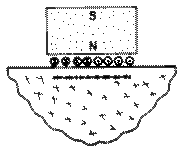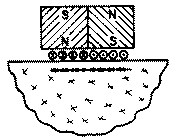Electromagnetic Acoustic Transducers (EMATs)
As discussed on the previous page, one of the essential features of ultrasonic measurements is mechanical coupling between the transducer and the solid whose properties or structure are to be studied. This coupling is generally achieved in one of two ways. In immersion measurements, energy is coupled between the transducer and sample by placing both objects in a tank filled with a fluid, generally water. In contact measurements, the transducer is pressed directly against the sample, and coupling is achieved by the presence of a thin fluid layer inserted between the two. When shear waves are to be transmitted, the fluid is generally selected to have a significant viscosity.
Electromagnetic-acoustic transducers (EMAT) acts through totally different physical principles and do not need couplant. When a wire is placed near the surface of an electrically conducting object and is driven by a current at the desired ultrasonic frequency, eddy currents will be induced in a near surface region of the object. If a static magnetic field is also present, these eddy currents will experience Lorentz forces of the form
F is the body force per unit volume, J is the induced dynamic current density, and B is the static magnetic induction.
The most important application of EMATs has been in nondestructive evaluation (NDE) applications such as flaw detection or material property characterization. Couplant free transduction allows operation without contact at elevated temperatures and in remote locations. The coil and magnet structure can also be designed to excite complex wave patterns and polarizations that would be difficult to realize with fluid coupled piezoelectric probes. In the inference of material properties from precise velocity or attenuation measurements, using EMATs can eliminate errors associated with couplant variation, particularly in contact measurements.
A number of practical EMAT configurations are shown below. In each, the biasing magnet structure, the coil, and the forces on the surface of the solid are shown in an exploded view. The first three configurations will excite beams propagating normal to the surface of the half-space and produce beams with radial, longitudinal, and transverse polarizations, respectively. The final two use spatially varying stresses to excite beams propagating at oblique angles or along the surface of a component. Although a great number of variations on these configurations have been conceived and used in practice, consideration of these three geometries should suffice to introduce the fundamentals.





Practical EMAT designs are relatively narrowband and require strong magnetic fields and large currents to produce ultrasound that is often weaker than that produced by piezoelectric transducers. Rare-earth materials such as Samarium-Cobalt and Neodymium-Iron-Boron are often used to produce sufficiently strong magnetic fields, which may also be generated by pulsed electromagnets.
The EMAT offers many advantages based on its couplant-free operation. These advantages include the abilities to operate in remote environments at elevated speeds and temperatures, to excite polarizations not easily excited by fluid coupled piezoelectrics, and to produce highly consistent measurements.
These advantages are tempered by low efficiencies, and careful electronic design is essential to applications.
More information about the use of EMATs can be found at the following links.
Lamb Wave Generation With EMATs
Shear Wave Generation With EMATs
Velocity Measurements With EMATs
Texture Measurement I With EMATs
Texture Measurement II With EMATs
Stress Measurement With EMATs
Composite inspection With EMATs